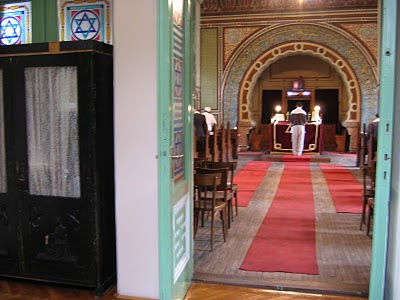Belzec. Photo (c) Ruth Ellen Gruber
In the aftermath of Saturday's plane disaster that claimed the life of Poland's President and dozens of other senior political, military and intellectual figures, most attention -- naturally -- has been paid to the death of President Lech Kaczynski.
As
many of the tributes to him point out, Kaczynski devoted much time and pro-active interest in promoting Jewish causes. He was the honorary patron of the annual
Festival of Jewish Culture in Krakow and was a key figure in the decision to found the
Museum of the History of Polish Jews, currently under construction in Warsaw: it was during Kaczynski's term as mayor of Warsaw that the city donated the land for the museum.
Others on the doomed plane, however, took an active role in fostering Jewish-Polish relations and, in particular, caring for Jewish heritage and Holocaust memorial sites. Many in the Jewish world lost close personal friends....
Tomasz Merta, Secretary of State in the Ministry of Culture and National Heirtage as well as the General Inspector of Monuments, is described by the
Auschwitz Memorial and Museum and "a man of exceptional insight, understanding and personal sacrifice for the cause of historical memory and the education of new generations."
In
an article for JTA, David Harris of the American Jewish Committee pays tribute in particular to the diplomat Mariusz Handzlik and Andrzej Przewoźnik, the secretary-general of the Council for the Protection of Struggle and Martyrdom Sites.
Mariusz and I shared a deep admiration for Jan Karski, the Polish wartime hero who later joined the faculty of Georgetown University. While serving in the United States, Mariusz befriended Karski, becoming his regular chess partner. They were playing chess when Karski suddenly felt ill and died shortly afterward. Together, Mariusz and I cried for this man who, at repeated risk to his own life, had tried to alert a largely deaf world to the Nazi’s Final Solution
And when Mariusz was assigned to the Polish Mission to the United Nations, he proudly told me that now he would be in a position, together with his colleagues, to help Israel in the world body. He wanted the Israelis to know they had friends at the United Nations, which largely was seen as hostile territory for Israel.
Andrzej Przewoźnik was secretary-general of the Council for the Protection of Struggle and Martyrdom Sites.
I first met him when the Polish government and the American Jewish Committee joined together to demarcate, protect, and memorialize the site of the Nazi death camp in Belzec, located in southeastern Poland. In less than a year, more than 500,000 Jews were killed in an area barely the size of a few football fields. Only two Jews survived.
In June 2004, after years of planning and construction, the site was inaugurated. As the late Miles Lerman said at that solemn ceremony, “No place of martyrdom anywhere is today as well protected and memorialized as Belzec.” That could not have occurred without Andrzej’s pivotal role. He helped make it happen, overcoming the multiple hurdles along the way. By doing so, he ensured that what took place at Belzec, long neglected by the Communists, would never be forgotten.
Belzec, indeed, is one of the most powerful memorials to the Shoah: the entire area of the camp has been turned into a sculpture... and there is also an excellent museum.







